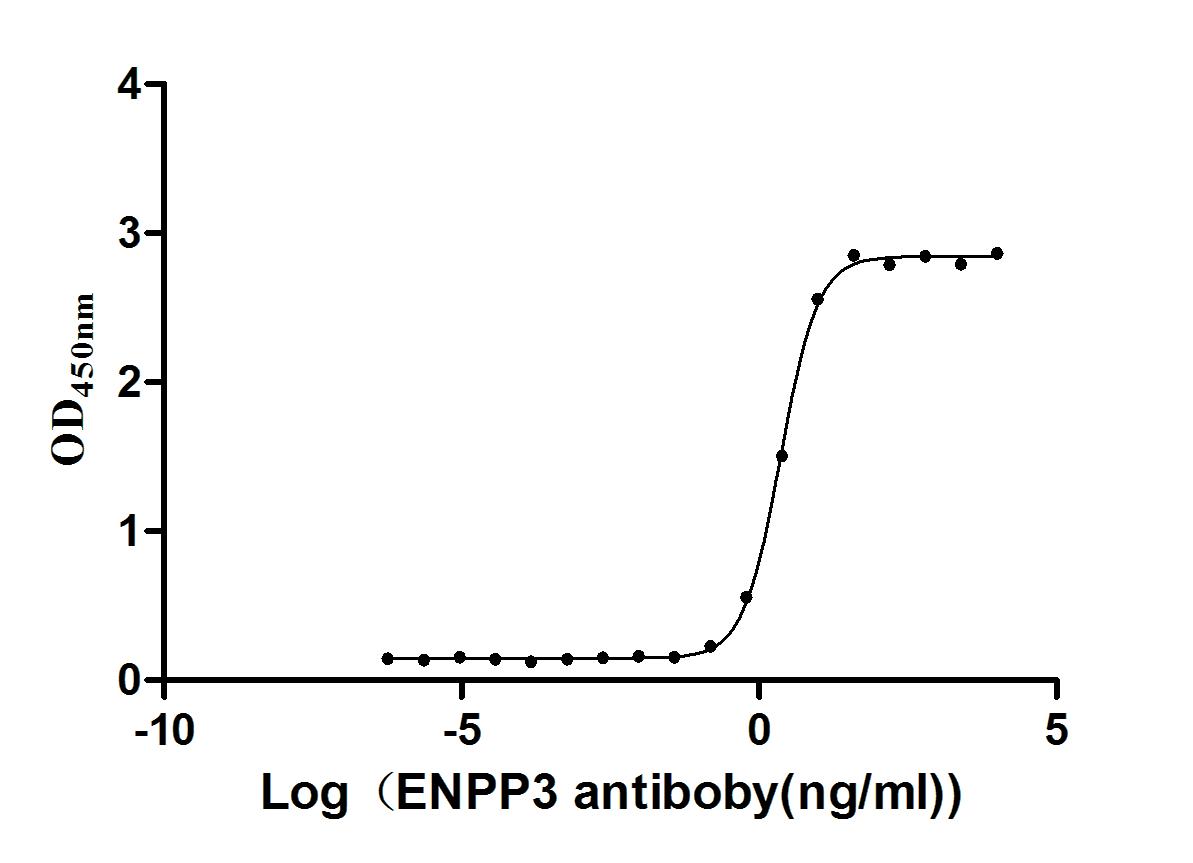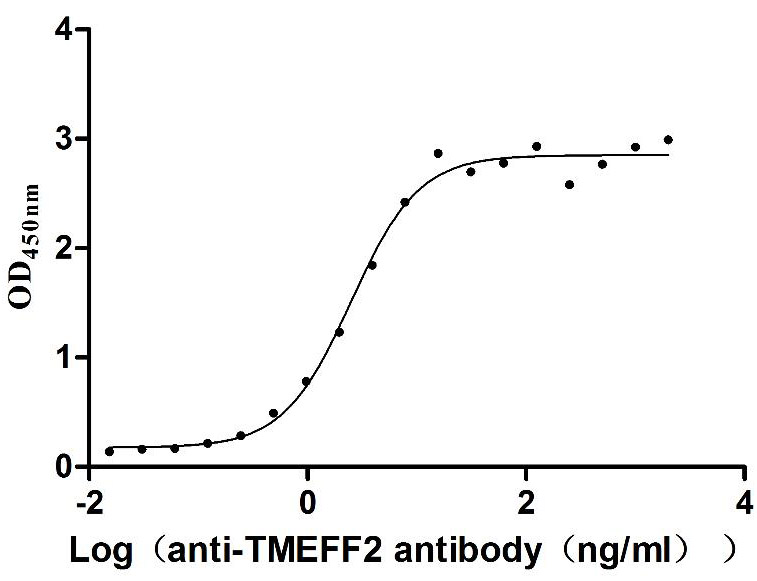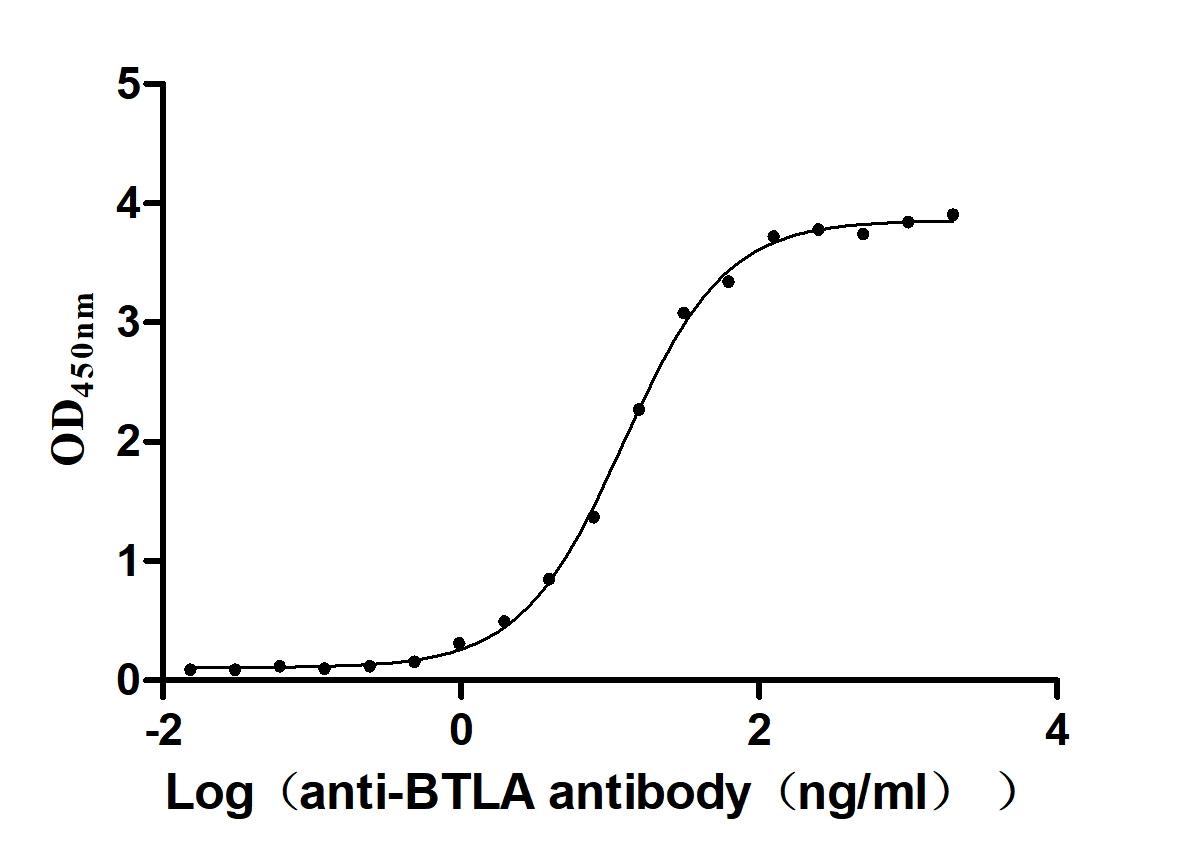Recombinant Human Heat-stable enterotoxin receptor (GUCY2C), partial
-
货号:CSB-YP010053HU
-
规格:
-
来源:Yeast
-
其他:
-
货号:CSB-EP010053HU
-
规格:
-
来源:E.coli
-
其他:
-
货号:CSB-EP010053HU-B
-
规格:
-
来源:E.coli
-
共轭:Avi-tag Biotinylated
E. coli biotin ligase (BirA) is highly specific in covalently attaching biotin to the 15 amino acid AviTag peptide. This recombinant protein was biotinylated in vivo by AviTag-BirA technology, which method is BriA catalyzes amide linkage between the biotin and the specific lysine of the AviTag.
-
其他:
产品详情
-
纯度:>85% (SDS-PAGE)
-
基因名:
-
Uniprot No.:
-
别名:GC-C; Guanylyl cyclase C; GUC2C; GUC2C_HUMAN; GUCY2C; Heat stable enterotoxin receptor; Heat-stable enterotoxin receptor; hSTAR; Intestinal guanylate cyclase; STA receptor
-
种属:Homo sapiens (Human)
-
蛋白长度:Partial
-
蛋白标签:Tag type will be determined during the manufacturing process.
The tag type will be determined during production process. If you have specified tag type, please tell us and we will develop the specified tag preferentially. -
产品提供形式:Lyophilized powder
Note: We will preferentially ship the format that we have in stock, however, if you have any special requirement for the format, please remark your requirement when placing the order, we will prepare according to your demand. -
复溶:We recommend that this vial be briefly centrifuged prior to opening to bring the contents to the bottom. Please reconstitute protein in deionized sterile water to a concentration of 0.1-1.0 mg/mL.We recommend to add 5-50% of glycerol (final concentration) and aliquot for long-term storage at -20℃/-80℃. Our default final concentration of glycerol is 50%. Customers could use it as reference.
-
储存条件:Store at -20°C/-80°C upon receipt, aliquoting is necessary for mutiple use. Avoid repeated freeze-thaw cycles.
-
保质期:The shelf life is related to many factors, storage state, buffer ingredients, storage temperature and the stability of the protein itself.
Generally, the shelf life of liquid form is 6 months at -20°C/-80°C. The shelf life of lyophilized form is 12 months at -20°C/-80°C. -
货期:Delivery time may differ from different purchasing way or location, please kindly consult your local distributors for specific delivery time.Note: All of our proteins are default shipped with normal blue ice packs, if you request to ship with dry ice, please communicate with us in advance and extra fees will be charged.
-
注意事项:Repeated freezing and thawing is not recommended. Store working aliquots at 4°C for up to one week.
-
Datasheet :Please contact us to get it.
相关产品
靶点详情
-
功能:Receptor for the E.coli heat-stable enterotoxin (E.coli enterotoxin markedly stimulates the accumulation of cGMP in mammalian cells expressing GC-C). Also activated by the endogenous peptides guanylin and uroguanylin.
-
基因功能参考文献:
- High Expressions of guanylyl cyclase C is associated with rectal cancer. PMID: 28418917
- The findings support that the activating mutation in GUCY2C creates an intestinal environment with a major influence on the microbiota, which could contribute to the increased susceptibility to inflammatory bowel disease in patients with Familial GUCY2C diarrhea syndrome. PMID: 28902124
- the expression of GCC is maintained throughout the process of tumor progression and formation of metastatic disease. PMID: 29261789
- To investigate gut motility and hormones before and after a meal in Familial GUCY2C diarrhea syndrome patients and compare with healthy controls PMID: 28957388
- Mutations in GUCY2C indicate a role for this receptor in the pathogenesis of sporadic Congenital secretory diarrhea. PMID: 25994218
- these data support Ad5-GUCY2C-PADRE as a safe and effective vaccination strategy in preclinical models and position Ad5-GUCY2C-PADRE for Phase I clinical testing in colorectal cancer patients. PMID: 27903079
- Familial GUCY2C diarrhoea syndrome is caused by an activating mutation in the GUCY2C gene, which causes impaired contractility and fluid stagnation in the small bowel PMID: 27338166
- Findings show how caloric suppression of the guanylin-GUCY2C signaling axis links obesity to negation of a universal tumor suppressor pathway in colorectal cancer. PMID: 26773096
- Data show that individuals affected with meconium ileus (MI) had either homozygous or compound heterozygous variants in enterotoxin receptor GUCY2C. PMID: 25370039
- High guanylyl cyclase C expression is associated with colon cancer recurrence. PMID: 24919572
- Transmission disequilibrium tests (TDT), case-control studies and quantitative analyses indicated association between GUC2C with Attention-deficit/hyperactivitydisorder and its core symptoms. PMID: 25064385
- Intestinal cell proliferation and senescence are regulated by receptor guanylyl cyclase C and p21. PMID: 24217248
- GUCY2C signaling constitutes a direct link between the initiation of colorectal cancer and the induction of its associated desmoplastic stromal niche. PMID: 24085786
- Data show that lower survival (OS) and disease-free survival (DFS) rates were significantly associated with guanylate cyclase C (GCC) and CK20 mRNA levels. PMID: 23150200
- Interaction with VIP36 is dependent on glycosylation at the same sites that allow GC-C to fold and bind ligand. PMID: 23269669
- GUCY2C opposes systemic genotoxic tumorigenesis by regulating AKT-dependent intestinal barrier integrity PMID: 22384056
- Mutations in GUCY2C were associated with the Meconium ileus phenotype. downregulation of GUCY2C leads to a cystic fibrosis-like intestinal phenotype. PMID: 22521417
- We identified a heterozygous missense mutation (c.2519G-->T) in GUCY2C in all family members with familial diarrhea syndrome. PMID: 22436048
- High guanylyl cyclase C is associated with colon cancer. PMID: 21533822
- Data suggest that monitoring the peripheral blood GCC expressions may allow employing different treatment options to metastatic CRC patients. PMID: 21901559
- Lymph nodes (range: 2-159) from 291 prospectively enrolled node-negative colorectal cancer patients were analyzed by histopathology and GUCY2C quantitative RT-PCR. PMID: 21307149
- Longer survival was associated with hypomethylation at specific CpG sites (e.g. GREB1, TGIF and TOB1) and hypermethylation in other genes (e.g. TMCO5, PTPRN and GUCY2C). PMID: 21577013
- A novel PDZ protein regulates the activity of guanylyl cyclase C, the heat-stable enterotoxin receptor. PMID: 11950846
- guanylyl cyclase c is ectopically expressed in primary and metastatis adenocarcinoma of the esophagus and stomach PMID: 12163327
- SH3 domain -mediated protein-protein interaction with the catalytic domain of guanylyl cyclase C inhibited the cyclase activity and might be pivotal for the desensitization phenomenon of the guanylyl cyclase C receptor PMID: 12649275
- gelatinolytic activity of GCC in colorectal tumor tissues may facilitate the hepatic metastatic process in the steps after intravasation but not during or before intravasation PMID: 14581363
- a novel role for glycosidic modification of GC-C during its biosynthesis, in imparting subtle conformational changes in the receptor that allow for ligand-mediated activation and perhaps regulation of basal activity PMID: 14748740
- Lack of guanylyl cyclase c expression assoeciated with significant reduction in adenomas in Apc(Min/+);Gucy2c(-/-) mice PMID: 15825168
- Transformation associated with reflux at the gastroesophageal junction reflects activation by bile acid and acid of a transcriptional program involving NF-kappaB and Cdx2, which mediate intestinal metaplasia and ectopic expression of GC-C. PMID: 16618413
- This validated assay is being applied to approximately 10,000 lymph nodes in a prospective trial to define the sensitivity of Guanylyl cyclase C(GCC) qRT-PCR for staging patients with colorectal cancer. PMID: 16899600
- docking of the c-src SH2 domain to phosphorylated GC-C results in colocalization and further activation of c-src. PMID: 19620276
- the role of the linker region in receptor guanylyl cyclases PMID: 19648115
- GCC is a specific marker for differentiating primary and secondary metatstatic ovarian mucinous neoplasms. PMID: 19694825
- Results suggest that GUCY2C quantitative reverse transcriptase (qRT)-PCR can be used to detect occult lymph node metastases in pN0 colorectal cancer patients. PMID: 19895223
- Expression of the receptor guanylyl cyclase C and its ligands in reproductive tissues of the rat: a potential role for a novel signaling pathway in the epididymis. PMID: 12444076
- The protein kinase-like domain in receptor guanylyl cyclase C provides a critical structural link between the extracellular domain and the catalytic domain in regulation of this family of receptors. PMID: 11478887
显示更多
收起更多
-
相关疾病:Diarrhea 6 (DIAR6); Meconium ileus (MECIL)
-
亚细胞定位:Cell membrane; Single-pass type I membrane protein. Endoplasmic reticulum membrane; Single-pass type I membrane protein. Note=The 145 kDa plasma membrane form of GC-C contains sialic acid and galactose residues, while a differencially glycosylated 130 Kda form is a high mannose form that is resident in the endoplasmic reticulum and may serve as the precursor for the cell surface form.
-
蛋白家族:Adenylyl cyclase class-4/guanylyl cyclase family
-
数据库链接:
HGNC: 4688
OMIM: 601330
KEGG: hsa:2984
STRING: 9606.ENSP00000261170
UniGene: Hs.524278
Most popular with customers
-
Recombinant Human Poliovirus receptor (PVR) (I340M), partial (Active)
Express system: Mammalian cell
Species: Homo sapiens (Human)
-
Express system: Mammalian cell
Species: Homo sapiens (Human)
-
Recombinant Human Claudin-9 (CLDN9)-VLPs (Active)
Express system: Mammalian cell
Species: Homo sapiens (Human)
-
Recombinant Human Claudin-4 (CLDN4)-VLPs (Active)
Express system: Mammalian cell
Species: Homo sapiens (Human)
-
Recombinant Macaca fascicularis Trophoblast glycoprotein (TPBG), partial (Active)
Express system: Mammalian cell
Species: Macaca fascicularis (Crab-eating macaque) (Cynomolgus monkey)
-
Recombinant Human Tomoregulin-2 (TMEFF2), partial (Active)
Express system: Mammalian cell
Species: Homo sapiens (Human)
-
Recombinant Human B- and T-lymphocyte attenuator(BTLA), partial (Active)
Express system: Mammalian cell
Species: Homo sapiens (Human)


-AC1.jpg)
















